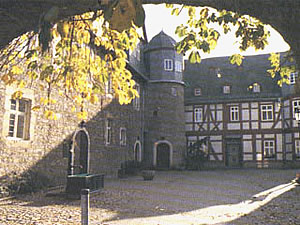8. The Wetterau Association of Counts (Wittgenstein,
Nassau-Dillenburg-Siegen, Wied)
The counties merged since the beginning of the 16th Century in the so-called
Wetterau Association of Counts had already introduced the Reformation
into their counties early on, e.g. William I in the County of Wittgenstein
from 1534 and William The Rich from 1533 in the County of Nassau-Siegen-Dillenburg.
On the basis of various contacts the counts had in the Electoral Palatinate
and the Swiss Confederation, but especially in the Netherlands, the attitudes
of the counts from after 1566 tended gradually towards the Reformed confession.
First and foremost among these was Count John VI of Nassau-Katzenelnbogen.
In 1576 the previous Wittenberg Professor Christoph Pezel had become
the preacher in Dillenburg, and in 1577 Count John officially professed
his allegiance to the Reformed confession. And already by 1578, a “Nassau
Confession” drawn up by Christoph Pezel was adopted. Although there
was clear mistrust of the introduction of the Reformed confession among
the people, there was at the same time no coercion on the part of the
count.
In 1584 Count John VI founded the high school in Herborn, which gained
a reputation stretching far beyond the county, among other things, owing
to the professor of law Johannes Althusius, and became a model for other
high schools (e.g. the one in Steinfurt).
The transition to the Reformed confession also gradually progressed in
Wittgenstein from 1565 on and gained a somewhat greater dynamic when
the previous Heidelberg theologian, Kaspar Olevian, became court chaplain
in Berleburg in 1576 (and from 1584 professor in Herborn).
 |
Herborner Hohe Schule Die Hohe Schule zu Herborn. Heute ist das Gebäude ein Hotel |
In 1586 a Reformed general synod of the counties Nassau-Siegen-Dillenburg,
Wittegenstein, Solms and Wied met in Herborn and a new church constitution
was passed (on the model of the Church Constitution of Middelburg of
1581). Two things stand out. First, a characteristic of this church constitution
is to combine the presbyterial-synodal constitution, according to which
the church is constructed from below (concretely, from the congregation),
with the regional rulers’ church rule, which portrays a church
from above, combining them in such a way that the presbyterial-synodal
element predominates. Second, it unites the churches in the county to
form a church embracing all regions. It is striking that the counts accepted
this constitution. The attempt of a re-Catholicisation of the Part-County
of Nassau-Siegen (in 1626, after the death of John VI, the county was
divided up) ultimately failed.
The Reformed congregations belong today either to the “Protestant
Church in Westphalia” or to the “Protestant Church of Hesse
and Nassau.” Some of the congregations have remained Reformed while
others have merged with Lutheran congregations to form united congregations.